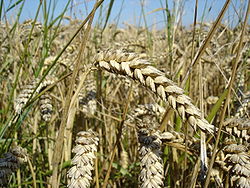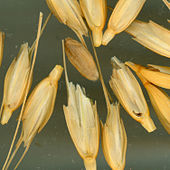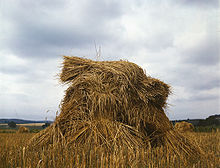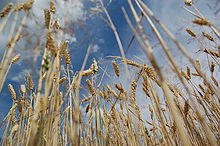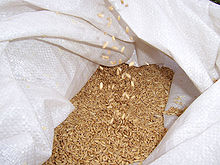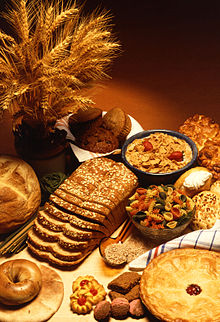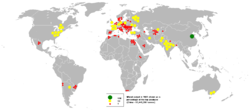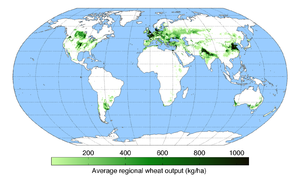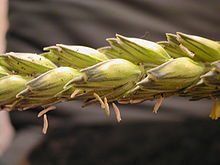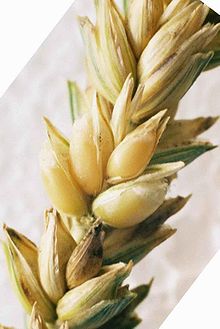- Wheat
-
This article is about the plant. For other uses, see Wheat (disambiguation).
Wheat Scientific classification Kingdom: Plantae (unranked): Angiosperms (unranked): Monocots (unranked): Commelinids Order: Poales Family: Poaceae Subfamily: Pooideae Tribe: Triticeae Genus: Triticum
L.Species T. aestivum
T. aethiopicum
T. araraticum
T. boeoticum
T. carthlicum
T. compactum
T. dicoccoides
T. dicoccum
T. durum
T. ispahanicum
T. karamyschevii
T. macha
T. militinae
T. monococcum
T. polonicum
T. spelta
T. sphaerococcum
T. timopheevii
T. turanicum
T. turgidum
T. urartu
T. vavilovii
T. zhukovskyiReferences:
Serial No. 42236 ITIS 2002-09-22Wheat (Triticum spp.)[1] is a cereal grain, originally from the Fertile Crescent region of the Near East but now cultivated worldwide. In 2007 world production of wheat was 607 million tons, making it the third most-produced cereal after maize (784 million tons) and rice (651 million tons).[2] Globally, wheat is the leading source of vegetable protein in human food, having a higher protein content than either maize (corn) or rice, the other major cereals. In terms of total production tonnages used for food, it is currently second to rice as the main human food crop and ahead of maize, after allowing for maize's more extensive use in animal feeds.
Wheat was a key factor enabling the emergence of city-based societies at the start of civilization because it was one of the first crops that could be easily cultivated on a large scale, and had the additional advantage of yielding a harvest that provides long-term storage of food. Wheat contributed to the emergence of city-states in the Fertile Crescent, including the Babylonian and Assyrian empires. Wheat grain is a staple food used to make flour for leavened, flat and steamed breads, biscuits, cookies, cakes, breakfast cereal, pasta, noodles, couscous[3] and for fermentation to make beer,[4] other alcoholic beverages,[5] or biofuel.[6]
Wheat is planted to a limited extent as a forage crop for livestock, and its straw can be used as a construction material for roofing thatch.[7][8] The whole grain can be milled to leave just the endosperm for white flour. The products of this are bran and germ. The whole grain is a concentrated source of vitamins, minerals, and protein, while the refined grain is mostly starch.
Contents
History
Wheat is one of the first cereals known to have been domesticated, and wheat's ability to self-pollinate greatly facilitated the selection of many distinct domesticated varieties. The archaeological record suggests that this first occurred in the regions known as the Fertile Crescent, and the Nile Delta. These include southeastern parts of Turkey, Lebanon, Syria, the Levant, Israel, and Egypt. Recent findings narrow the first domestication of wheat down to a small region of southeastern Turkey,[9] and domesticated Einkorn wheat at Nevalı Çori—40 miles (64 km) northwest of Gobekli Tepe in Turkey—has been dated to 9,000 B.C.[10] However evidence for the exploitation of wild barley has been dated to 23,000 B.C. and some say this is also true of pre-domesticated wheat.[11]
Origin
Archaeological analysis of wild emmer indicates that it was first cultivated in the southern Levant with finds at Iraq ed-Dubb in northern Jordan dating back as far as 9600 BC.[12][13] Genetic analysis of wild einkorn wheat suggests that it was first grown in the Karacadag Mountains in southeastern Turkey. Dated archeological remains of einkorn wheat in settlement sites near this region, including those at Abu Hureyra in Syria, suggests the domestication of einkorn near the Karacadag Mountain Range. With the anomalous exception of two grains from Iraq ed-Dubb, the earliest carbon-14 date for einkorn wheat remains at Abu Hureyra is 7800 to 7500 years BC.[14] Remains of harvested emmer from several sites near the Karacadag Range have been dated to between 8600 (at Cayonu) and 8400 BC (Abu Hureyra), that is, in the Neolithic period. With the exception of Iraq ed-Dubb, the earliest carbon-14 dated remains of domesticated emmer wheat were found in the earliest levels of Tell Aswad, in the Damascus basin, near Mount Hermon in Syria. These remains were dated by Willem van Zeist and his assistant Johanna Bakker-Heeres to 8800 BCE. They also concluded that the settlers of Tell Aswad did not develop this form of emmer themselves, but brought the domesticated grains with them from an as yet unidentified location elsewhere.[15]
Cultivation and repeated harvesting and sowing of the grains of wild grasses led to the creation of domestic strains, as mutant forms ('sports') of wheat were preferentially chosen by farmers. In domesticated wheat, grains are larger, and the seeds (spikelets) remain attached to the ear by a toughened rachis during harvesting. In wild strains, a more fragile rachis allows the ear to easily shatter and disperse the spikelets.[16] Selection for these traits by farmers might not have been deliberately intended, but simply have occurred because these traits made gathering the seeds easier; nevertheless such 'incidental' selection was an important part of crop domestication. As the traits that improve wheat as a food source also involve the loss of the plant's natural seed dispersal mechanisms, highly domesticated strains of wheat cannot survive in the wild.
Cultivation of wheat began to spread beyond the Fertile Crescent after about 8000 BC. Jared Diamond traces the spread of cultivated emmer wheat starting in the Fertile Crescent about 8500 BC, reaching Greece, Cyprus and India by 6500 BC, Egypt shortly after 6000 BC, and Germany and Spain by 5000 BC.[17] "The early Egyptians were developers of bread and the use of the oven and developed baking into one of the first large-scale food production industries." [18] By 3000 BCE, wheat had reached England, and Scandinavia. A millennium later it reached China.
Wheat spread throughout Europe and in England; thatch was used for roofing in the Bronze Age, and was in common use until the late 19th century.[19]
Farming techniques
Technological advances in soil preparation and seed placement at planting time, use of crop rotation and fertilizers to improve plant growth, and advances in harvesting methods have all combined to promote wheat as a viable crop. Agricultural cultivation using horse collar leveraged plows (at about 3000 BCE) was one of the first innovations that increased productivity. Much later, when the use of seed drills replaced broadcasting sowing of seed in the 18th century, another great increase in productivity occurred. Yields of wheat per unit area increased as methods of crop rotation were applied to long cultivated land, and the use of fertilizers became widespread. Improved agricultural husbandry has more recently included threshing machines and reaping machines (the 'combine harvester'), tractor-drawn cultivators and planters, and better varieties (see Green Revolution and Norin 10 wheat). Great expansions of wheat production occurred as new arable land was farmed in the Americas and Australia in the 19th and 20th centuries.
Genetics
Wheat genetics is more complicated than that of most other domesticated species. Some wheat species are diploid, with two sets of chromosomes, but many are stable polyploids, with four sets of chromosomes (tetraploid) or six (hexaploid).[20]
- Einkorn wheat (T. monococcum) is diploid (AA, two complements of seven chromosomes, 2n=14).[1]
- Most tetraploid wheats (e.g. emmer and durum wheat) are derived from wild emmer, T. dicoccoides. Wild emmer is itself the result of a hybridization between two diploid wild grasses, T. urartu and a wild goatgrass such as Aegilops searsii or Ae. speltoides. The unknown grass has never been identified among now surviving wild grasses, but the closest living relative is Aegilops speltoides.[citation needed] The hybridization that formed wild emmer (AABB) occurred in the wild, long before domestication,[20] and was driven by natural selection.
- Hexaploid wheats evolved in farmers' fields. Either domesticated emmer or durum wheat hybridized with yet another wild diploid grass (Aegilops cylindrica) to make the hexaploid wheats, spelt wheat and bread wheat.[20] These have three sets of paired chromosomes, three times as many as in diploid wheat.
The presence of certain versions of wheat genes has been important for crop yields. Apart from mutant versions of genes selected in antiquity during domestication, there has been more recent deliberate selection of alleles that affect growth characteristics. Genes for the 'dwarfing' trait, first used by Japanese wheat breeders to produce short-stalked wheat, have had a huge effect on wheat yields world-wide, and were major factors in the success of the Green Revolution in Mexico and Asia. Dwarfing genes enable the carbon that is fixed in the plant during photosynthesis to be diverted towards seed production, and they also help prevent the problem of lodging. 'Lodging' occurs when an ear stalk falls over in the wind and rots on the ground, and heavy nitrogenous fertilization of wheat makes the grass grow taller and become more susceptible to this problem. By 1997, 81% of the developing world's wheat acreage was planted to semi-dwarf wheats, giving both increased yields and better response to nitrogenous fertilizer.
Wild grasses in the genus Triticum and related genera, and grasses such as rye have been a source of many disease-resistance traits for cultivated wheat breeding since the 1930s.[21]
Heterosis, or hybrid vigor (as in the familiar F1 hybrids of maize), occurs in common (hexaploid) wheat, but it is difficult to produce seed of hybrid cultivars on a commercial scale (as is done with maize) because wheat flowers are complete and normally self-pollinate. Commercial hybrid wheat seed has been produced using chemical hybridizing agents; these chemicals selectively interfere with pollen development, or naturally occurring cytoplasmic male sterility systems. Hybrid wheat has been a limited commercial success in Europe (particularly France), the USA and South Africa.[22] F1 hybrid wheat cultivars should not be confused with the standard method of breeding inbred wheat cultivars by crossing two lines using hand emasculation, then selfing or inbreeding the progeny many (ten or more) generations before release selections are identified to be released as a variety or cultivar.
Synthetic hexaploids made by crossing the wild goatgrass wheat ancestor Aegilops tauschii and various durum wheats are now being deployed, and these increase the genetic diversity of cultivated wheats.[23]
Stomata (or leaf pores) are involved in both uptake of carbon dioxide gas from the atmosphere and water vapor losses from the leaf due to water transpiration. Basic physiological investigation of these gas exchange processes has yielded valuable carbon isotope based methods that are used for breeding wheat varieties with improved water-use efficiency. These varieties can improve crop productivity in rain-fed dry-land wheat farms.[24]
In 2010, a team of UK scientists funded by BBSRC announced they had decoded the wheat genome for the first time (95% of the genome of a variety of wheat known as Chinese Spring line 42).[25] This was the expressed genome and was released in a basic format for scientists and plant breeders to use but was not a fully annotated sequence which was reported in some of the media.[26] A fully annotated sequence is being assembled by a global consortium (IWGSC http://www.wheatgenome.org/), including members of this team.
Plant breeding
In traditional agricultural systems wheat populations often consist of landraces, informal farmer-maintained populations that often maintain high levels of morphological diversity. Although landraces of wheat are no longer grown in Europe and North America, they continue to be important elsewhere. The origins of formal wheat breeding lie in the nineteenth century, when single line varieties were created through selection of seed from a single plant noted to have desired properties. Modern wheat breeding developed in the first years of the twentieth century and was closely linked to the development of Mendelian genetics. The standard method of breeding inbred wheat cultivars is by crossing two lines using hand emasculation, then selfing or inbreeding the progeny. Selections are identified (shown to have the genes responsible for the varietal differences) ten or more generations before release as a variety or cultivar.[27]
F1 hybrid wheat cultivars should not be confused with wheat cultivars deriving from standard plant breeding. Heterosis or hybrid vigor (as in the familiar F1 hybrids of maize) occurs in common (hexaploid) wheat, but it is difficult to produce seed of hybrid cultivars on a commercial scale as is done with maize because wheat flowers are complete and normally self-pollinate.[27] Commercial hybrid wheat seed has been produced using chemical hybridizing agents, plant growth regulators that selectively interfere with pollen development, or naturally occurring cytoplasmic male sterility systems. Hybrid wheat has been a limited commercial success in Europe (particularly France), the United States and South Africa.[28]
The major breeding objectives include high grain yield, good quality, disease and insect resistance and tolerance to abiotic stresses include mineral, moisture and heat tolerance. The major diseases in temperate environments include the following, arranged in a rough order of their significance from cooler to warmer climates: eyespot, Stagonospora nodorum blotch (also known as glume blotch), yellow or stripe rust, powdery mildew, Septoria tritici blotch (sometimes known as leaf blotch), brown or leaf rust, Fusarium head blight, tan spot and stem rust. In tropical areas, spot blotch (also known as Helminthosporium leaf blight) is also important.
Hulled versus free-threshing wheat
The four wild species of wheat, along with the domesticated varieties einkorn,[29] emmer[30] and spelt,[31] have hulls. This more primitive morphology (in evolutionary terms) consists of toughened glumes that tightly enclose the grains, and (in domesticated wheats) a semi-brittle rachis that breaks easily on threshing. The result is that when threshed, the wheat ear breaks up into spikelets. To obtain the grain, further processing, such as milling or pounding, is needed to remove the hulls or husks. In contrast, in free-threshing (or naked) forms such as durum wheat and common wheat, the glumes are fragile and the rachis tough. On threshing, the chaff breaks up, releasing the grains. Hulled wheats are often stored as spikelets because the toughened glumes give good protection against pests of stored grain.[29]
Naming
There are many botanical classification systems used for wheat species, discussed in a separate article on Wheat taxonomy. The name of a wheat species from one information source may not be the name of a wheat species in another.
Within a species, wheat cultivars are further classified by wheat breeders and farmers in terms of:
- growing season, such as winter wheat vs. spring wheat,[8] by gluten content, such as hard wheat (high protein content) vs. soft wheat (high starch content), or by grain color (red, white or amber).
- Protein content. Bread wheat protein content ranges from 10% in some soft wheats with high starch contents, to 15% in hard wheats.
- The quality of the wheat protein gluten. This protein can determine the suitability of a wheat to a particular dish. A strong and elastic gluten present in bread wheats enables dough to trap carbon dioxide during leavening, but elastic gluten interferes with the rolling of pasta into thin sheets. The gluten protein in durum wheats used for pasta is strong but not elastic.
- Grain color (red, white or amber). Many wheat varieties are reddish-brown due to phenolic compounds present in the bran layer which are transformed to pigments by browning enzymes. White wheats have a lower content of phenolics and browning enzymes, and are generally less astringent in taste than red wheats. The yellowish color of durum wheat and semolina flour made from it is due to a carotenoid pigment called lutein, which can be oxidized to a colorless form by enzymes present in the grain.
Major cultivated species of wheat
- Common wheat or Bread wheat (T. aestivum) – A hexaploid species that is the most widely cultivated in the world.
- Durum (T. durum) – The only tetraploid form of wheat widely used today, and the second most widely cultivated wheat.
- Einkorn (T. monococcum) – A diploid species with wild and cultivated variants. Domesticated at the same time as emmer wheat, but never reached the same importance.
- Emmer (T. dicoccum) – A tetraploid species, cultivated in ancient times but no longer in widespread use.
- Spelt (T. spelta) – Another hexaploid species cultivated in limited quantities.
Classes used in the United States are
- Durum – Very hard, translucent, light-colored grain used to make semolina flour for pasta and bulghur.
- Hard Red Spring – Hard, brownish, high-protein wheat used for bread and hard baked goods. Bread Flour and high-gluten flours are commonly made from hard red spring wheat. It is primarily traded at the Minneapolis Grain Exchange.
- Hard Red Winter – Hard, brownish, mellow high-protein wheat used for bread, hard baked goods and as an adjunct in other flours to increase protein in pastry flour for pie crusts. Some brands of unbleached all-purpose flours are commonly made from hard red winter wheat alone. It is primarily traded by the Kansas City Board of Trade. One variety is known as "turkey red wheat", and was brought to Kansas by Mennonite immigrants from Russia.[32]
- Soft Red Winter – Soft, low-protein wheat used for cakes, pie crusts, biscuits, and muffins. Cake flour, pastry flour, and some self-rising flours with baking powder and salt added, for example, are made from soft red winter wheat. It is primarily traded by the Chicago Board of Trade.
- Hard White – Hard, light-colored, opaque, chalky, medium-protein wheat planted in dry, temperate areas. Used for bread and brewing.
- Soft White – Soft, light-colored, very low protein wheat grown in temperate moist areas. Used for pie crusts and pastry. Pastry flour, for example, is sometimes made from soft white winter wheat.
Red wheats may need bleaching; therefore, white wheats usually command higher prices than red wheats on the commodities market.
As a food
Wheat germ crude (not whole grain) Nutritional value per 100 g (3.5 oz) Energy 1,506 kJ (360 kcal) Carbohydrates 51.8 g - Dietary fiber 13.2 g Fat 9.72 g Protein 23.15 g Thiamine (vit. B1) 1.882 mg (164%) Riboflavin (vit. B2) 0.499 mg (42%) Niacin (vit. B3) 6.813 mg (45%) Pantothenic acid (B5) 0.05 mg (1%) Vitamin B6 1.3 mg (100%) Folate (vit. B9) 281 μg (70%) Calcium 39 mg (4%) Iron 6.26 mg (48%) Magnesium 239 mg (67%) Phosphorus 842 mg (120%) Potassium 892 mg (19%) Zinc 12.29 mg (129%) Manganese 13.301 mg Percentages are relative to US recommendations for adults.
Source: USDA Nutrient DatabaseRaw wheat can be ground into flour or, using hard durum wheat only, can be ground into semolina; germinated and dried creating malt; crushed or cut into cracked wheat; parboiled (or steamed), dried, crushed and de-branned into bulgur also known as groats. If the raw wheat is broken into parts at the mill, as is usually done, the outer husk or bran can be used several ways. Wheat is a major ingredient in such foods as bread, porridge, crackers, biscuits, Muesli, pancakes, pies, pastries, cakes, cookies, muffins, rolls, doughnuts, gravy, boza (a fermented beverage), and breakfast cereals (e.g., Wheatena, Cream of Wheat, Shredded Wheat, and Wheaties).
Nutrition
100 grams of hard red winter wheat[clarification needed] contain about 12.6 grams of protein, 1.5 grams of total fat, 71 grams of carbohydrate (by difference), 12.2 grams of dietary fiber, and 3.2 mg of iron (17% of the daily requirement); the same weight of hard red spring wheat contains about 15.4 grams of protein, 1.9 grams of total fat, 68 grams of carbohydrate (by difference), 12.2 grams of dietary fiber, and 3.6 mg of iron (20% of the daily requirement).[33]
Much of the carbohydrate fraction of wheat is starch. Wheat starch is an important commercial product of wheat, but second in economic value to wheat gluten.[34] The principal parts of wheat flour are gluten and starch. These can be separated in a kind of home experiment, by mixing flour and water to form a small ball of dough, and kneading it gently while rinsing it in a bowl of water. The starch falls out of the dough and sinks to the bottom of the bowl, leaving behind a ball of gluten.
Health concerns
Roughly 1% of the Indian population[35][36] has coeliac (also written as celiac) disease—a condition that is caused by an adverse immune system reaction to gliadin, a gluten protein found in wheat (and similar proteins of the tribe Triticeae which includes other species such as barley and rye). Upon exposure to gliadin, the enzyme tissue transglutaminase modifies the protein, and the immune system cross-reacts with the bowel tissue, causing an inflammatory reaction. That leads to flattening of the lining of the small intestine, which interferes with the absorption of nutrients. The only effective treatment is a lifelong gluten-free diet.
The estimate for people in the United States is between 0.5 and 1.0 percent of the population.[37][38][39]
While the disease is caused by a reaction to wheat proteins, it is not the same as wheat allergy.
Synopsis of major staple food
Synopsis[40] of staple food ~composition: Amaranth[41] Wheat[42] Rice[43] Sweetcorn[44] Potato[45] Component (per 100g portion) Amount Amount Amount Amount Amount water (g) 11 11 12 76 82 energy (kJ) 1554 1506 1527 360 288 protein (g) 14 23 7 3 1.7 fat (g) 7 1.9 1 1 0.1 carbohydrates (g) 65 52 79 19 16 fiber (g) 7 13 1 3 2.4 sugars (g) 1.7 0.1 >0.1 3 1.2 iron (mg) 7.6 6.3 0.8 0.5 0.5 manganese (mg) 3.4 13.3 1.1 0.2 0.1 calcium (mg) 159 39 28 2 9 magnesium (mg) 248 239 25 37 21 phosphorus (mg) 557 842 115 89 62 potassium (mg) 508 892 115 270 407 zinc (mg) 2.9 12.3 1.1 0.5 0.3 panthothenic acid (mg) 1.5 0.1 1.0 0.7 0.3 vitB6 (mg) 0.6 1.3 0.2 0.1 0.2 folate (µg) 82 281 8 42 18 thiamin (mg) 0.1 1.9 0.1 0.2 0.1 riboflavin (mg) 0.2 0.5 >0.1 0.1 >0.1 niacin (mg) 0.9 6.8 1.6 1.8 1.1 Commercial use
Harvested wheat grain that enters trade is classified according to grain properties for the purposes of the commodities market. Wheat buyers use these to decide which wheat to buy, as each class has special uses, and producers use them to decide which classes of wheat will be most profitable to cultivate.
Wheat is widely cultivated as a cash crop because it produces a good yield per unit area, grows well in a temperate climate even with a moderately short growing season, and yields a versatile, high-quality flour that is widely used in baking. Most breads are made with wheat flour, including many breads named for the other grains they contain like most rye and oat breads. The popularity of foods made from wheat flour creates a large demand for the grain, even in economies with significant food surpluses.
In recent years, low international wheat prices have often encouraged farmers in the USA to change to more profitable crops. In 1998, the price at harvest was $2.68 per bushel. A USDA report[46] revealed that in 1998, average operating costs were $1.43 per bushel and total costs were $3.97 per bushel. In that study, farm wheat yields averaged 41.7 bushels per acre (2.2435 metric ton / hectare), and typical total wheat production value was $31,900 per farm, with total farm production value (including other crops) of $173,681 per farm, plus $17,402 in government payments. There were significant profitability differences between low- and high-cost farms, mainly due to crop yield differences, location, and farm size.
In 2007 there was a dramatic rise in the price of wheat due to freezes and flooding in the northern hemisphere and a drought in Australia. Wheat futures in September, 2007 for December and March delivery had risen above $9.00 a bushel, prices never seen before.[47] There were complaints in Italy about the high price of pasta.[48] This followed a wider trend of escalating food prices around the globe, driven in part by climatic conditions such as drought in Australia, the diversion of arable land to other uses (such as producing government-subsidised bio-oil crops), and later by some food-producing nations placing bans or restrictions on exports in order to satisfy their own consumers.
Other drivers affecting wheat prices include the movement to bio fuels and rising incomes in developing countries, which is causing a shift in eating patterns from predominantly rice to more meat based diets (a rise in meat production equals a rise in grain consumption—seven kilograms of grain is required to produce one kilogram of beef).[49]
Production and consumption
In 2003, global per capita wheat consumption was 67 kg, with the highest per capita consumption (239 kg) found in Kyrgyzstan.[50] In 1997, global wheat consumption was 101 kg per capita, with the highest consumption (623 kg per capita) in Denmark, but most of this (81%) was for animal feed.[51] Wheat is the primary food staple in North Africa and the Middle East, and is growing in popularity in Asia. Unlike rice, wheat production is more widespread globally though China's share is almost one-sixth of the world.
In the 20th century, global wheat output expanded by about 5-fold, but until about 1955 most of this reflected increases in wheat crop area, with lesser (about 20%) increases in crop yields per unit area. After 1955 however, there was a dramatic ten-fold increase in the rate of wheat yield improvement per year, and this became the major factor allowing global wheat production to increase. Thus technological innovation and scientific crop management with synthetic nitrogen fertilizer, irrigation and wheat breeding were the main drivers of wheat output growth in the second half of the century. There were some significant decreases in wheat crop area, for instance in North America.[52]
Better seed storage and germination ability (and hence a smaller requirement to retain harvested crop for next year's seed) is another 20th century technological innovation. In Medieval England, farmers saved one-quarter of their wheat harvest as seed for the next crop, leaving only three-quarters for food and feed consumption. By 1999, the global average seed use of wheat was about 6% of output.
Several factors are currently slowing the rate of global expansion of wheat production: population growth rates are falling while wheat yields continue to rise, and the better economic profitability of other crops such as soybeans and maize, linked with investment in modern genetic technologies, has promoted shifts to other crops.
Farming systems
In the Punjab region of India and Pakistan, as well as North China, irrigation has been a major contributor to increased grain output. More widely over the last 40 years, a massive increase in fertilizer use together with the increased availability of semi-dwarf varieties in developing countries, has greatly increased yields per hectare. In developing countries, use of (mainly nitrogenous) fertilizer increased 25-fold in this period. However, farming systems rely on much more than fertilizer and breeding to improve productivity. A good illustration of this is Australian wheat growing in the southern winter cropping zone, where, despite low rainfall (300 mm), wheat cropping is successful even with relatively little use of nitrogenous fertilizer. This is achieved by 'rotation cropping' (traditionally called the ley system) with leguminous pastures and, in the last decade, including a canola crop in the rotations has boosted wheat yields by a further 25% .[53] In these low rainfall areas, better use of available soil-water (and better control of soil erosion) is achieved by retaining the stubble after harvesting and by minimizing tillage.[54]
Futures contracts
Wheat futures are traded on the Chicago Board of Trade, Kansas City Board of Trade, and Minneapolis Grain Exchange, and have delivery dates in March (H), May (K), July (N), September (U), and December (Z).[55]
Top Ten Wheat Producers — 2008 (million metric ton)  People's Republic of China
People's Republic of China112  India
India79  United States
United States68  Russia
Russia64  France
France39  Canada
Canada29  Germany
Germany26  Ukraine
Ukraine26  Australia
Australia21  Pakistan
Pakistan21 World Total 690 Source: UN Food & Agriculture Organisation (FAO)[56] Geographical variation
There are substantial differences in wheat farming, trading, policy, sector growth, and wheat uses in different regions of the world. In the EU and Canada for instance, there is significant addition of wheat to animal feeds, but less so in the USA.
The two biggest wheat producers are China and the EU, followed currently by India, then USA. Developed countries USA, Canada, Australia, the EU and increasingly Argentina are the major exporters with developing countries being the main importers, although both India and China are close to being self-sufficient in wheat. In the rapidly developing countries of Asia, Westernization of diets associated with increasing prosperity is leading to growth in per capita demand for wheat at the expense of the other food staples.
In the past, there has been significant governmental intervention in wheat markets, such as price supports in the USA and farm payments in the EU. In the EU these subsidies have encouraged heavy use of fertilizers inputs with resulting high crop yields. In Australia and Argentina direct government subsidies are much lower.[57]
Agronomy
Crop development
Wheat normally needs between 110 and 130 days between planting and harvest, depending upon climate, seed type, and soil conditions (winter wheat lies dormant during a winter freeze). Optimal crop management requires that the farmer have a detailed understanding of each stage of development in the growing plants. In particular, spring fertilizers, herbicides, fungicides, growth regulators are typically applied only at specific stages of plant development. For example, it is currently recommended that the second application of nitrogen is best done when the ear (not visible at this stage) is about 1 cm in size (Z31 on Zadoks scale). Knowledge of stages is also important to identify periods of higher risk from the climate. For example, pollen formation from the mother cell, and the stages between anthesis and maturity are susceptible to high temperatures, and this adverse effect is made worse by water stress.[58] Farmers also benefit from knowing when the 'flag leaf' (last leaf) appears, as this leaf represents about 75% of photosynthesis reactions during the grain filling period, and so should be preserved from disease or insect attacks to ensure a good yield.
Several systems exist to identify crop stages, with the Feekes and Zadoks scales being the most widely used. Each scale is a standard system which describes successive stages reached by the crop during the agricultural season.
Diseases
There are many wheat diseases, mainly caused by fungi, bacteria, and viruses.[59] Plant breeding to develop new disease-resistant varieties, and sound crop management practices are important for preventing disease. Fungicides, used to prevent the significant crop losses from fungal disease, can be a significant variable cost in wheat production. Estimates of the amount of wheat production lost owing to plant diseases vary between 10–25% in Missouri.[60] A wide range of organisms infect wheat, of which the most important are viruses and fungi.
The main wheat-disease categories are:
- Seed-borne diseases: these include seed-borne scab, seed-borne Stagonospora (previously known as Septoria), common bunt (stinking smut), and loose smut. These are managed with fungicides.
- Leaf- and head- blight diseases: Powdery mildew, leaf rust, Septoria tritici leaf blotch, Stagonospora (Septoria) nodorum leaf and glume blotch, and Fusarium head scab [61].
- Crown and root rot diseases: Two of the more important of these are 'take-all' and Cephalosporium stripe. Both of these diseases are soil borne.
- Viral diseases: Wheat spindle streak mosaic (yellow mosaic) and barley yellow dwarf are the two most common viral diseases. Control can be achieved by using resistant varieties.
Pests
Wheat is used as a food plant by the larvae of some Lepidoptera (butterfly and moth) species including The Flame, Rustic Shoulder-knot, Setaceous Hebrew Character and Turnip Moth. Early in the season, birds and rodents can also cause significant damage to a crop by digging up and eating newly planted seeds or young plants. They can also damage the crop late in the season by eating the grain from the mature spike. Recent post-harvest losses in cereals amount to billions of dollars per year in the USA alone, and damage to wheat by various borers, beetles and weevils is no exception.[62] Rodents can also cause major losses during storage, and in major grain growing regions, field mice numbers can sometimes build up explosively to plague proportions because of the ready availability of food.[63] To reduce the amount of wheat lost to post-harvest pests, Agricultural Research Service scientists have developed an “insect-o-graph,” which can detect insects in wheat that are not visible to the naked eye. The device uses electrical signals to detect the insects as the wheat is being milled. The new technology is so precise that it can detect 5-10 infested seeds out of 300,000 good ones.[64] Tracking insect infestations in stored grain is critical for food safety as well as for the marketing value of the crop.
See also
- Bran
- Chaff
- Deficit irrigation
- History of agriculture in the United States#Wheat
- Husk
- Wheat germ oil
- Wheat middlings
- Whole wheat flour
References
- ^ a b Belderok, Bob & Hans Mesdag & Dingena A. Donner. (2000) Bread-Making Quality of Wheat. Springer. p.3. ISBN 0-7923-6383-3.
- ^ "Faostat". 2007. http://faostat.fao.org/site/526/default.aspx. Retrieved 2009-05-05.
- ^ Cauvain, Stanley P. & Cauvain P. Cauvain. (2003) Bread Making. CRC Press. p. 540. ISBN 1-85573-553-9.
- ^ Palmer, John J. (2001) How to Brew. Defenestrative Pub Co. p. 233. ISBN 0-9710579-0-7.
- ^ Neill, Richard. (2002) Booze: The Drinks Bible for the 21st Century. Octopus Publishing Group - Cassell Illustrated. p. 112. ISBN 1-84188-196-1.
- ^ Department of Agriculture Appropriations for 1957: Hearings ... 84th Congress. 2d Session. United States House Committee on Appropriations. 1956. p. 242.
- ^ Smith, Albert E. (1995) Handbook of Weed Management Systems. Marcel Dekker. p. 411. ISBN 0-8247-9547-4.
- ^ a b Bridgwater, W. & Beatrice Aldrich. (1966) The Columbia-Viking Desk Encyclopedia. Columbia University. p. 1959.
- ^ Lev-Yadun, S; Gopher, A; Abbo, S (2000). "The cradle of agriculture". Science 288 (5471): 1602–3. doi:10.1126/science.288.5471.1602. PMID 10858140.
- ^ "Which came first, monumental building projects or farming?". Archaeo News. 2008-12-14. http://www.stonepages.com/news/archives/003061.html.
- ^ [|Piperno, Dolores]; et al. (2004-06-04). "Processing of wild cereal grains in the Upper Palaeolithic revealed by starch grain analysis". Nature 430 (7000): 670–673. doi:10.1038/nature02734. PMID 15295598. http://www.nature.com/nature/journal/v430/n7000/abs/nature02734.html.
- ^ Feldman, Moshe and Kislev, Mordechai E., Israel Journal of Plant Sciences, Volume 55, Number 3 - 4 / 2007, pp. 207 - 221, Domestication of emmer wheat and evolution of free-threshing tetraploid wheat in "A Century of Wheat Research-From Wild Emmer Discovery to Genome Analysis", Published Online: 03 November 2008
- ^ Sue Colledge; University College, London. Institute of Archaeology (2007). The origins and spread of domestic plants in southwest Asia and Europe. Left Coast Press. pp. 40–. ISBN 9781598749885. http://books.google.com/books?id=D2nym35k_EcC&pg=PA40. Retrieved 5 July 2011.
- ^ Heun MR et al (1997) Site of Einkorn Wheat Domestication Identified by DNA Fingerprinting Science 278:1312-4 DOI: 10.1126/science.278.5341.1312
- ^ Ozkan, H; Brandolini, A; Schäfer-Pregl, R; Salamini, F (October 2002). "AFLP analysis of a collection of tetraploid wheats indicates the origin of emmer and hard wheat domestication in southeast Turkey". Molecular biology and evolution 19 (10): 1797–801. PMID 12270906. http://mbe.oxfordjournals.org/cgi/content/full/19/10/1797.
- ^ Tanno, K Willcox; Willcox, G (2006). "How fast was wild wheat domesticated?". Science 311 (5769): 1886. doi:10.1126/science.1124635. PMID 16574859.
- ^ Diamond J (1997) Guns, Germs and Steel, A short history of everybody for the last 13,000 years. Viking UK Random House ISBN 0-09-930278-0
- ^ Direct quotation: Grundas ST : Chapter: Wheat: The Crop, in Encyclopedia of Food Sciences and Nutrition p6130, 2003; Elsevier Science Ltd
- ^ Belderok B et al. (2000) Bread-Making Quality of Wheat Springer p 3 ISBN 0-7923-6383-3
- Abengoa And Dyadic Sign Ethanol R&D Agreement Posted Oct 31st, 2006
- Cauvain SP, Cauvain P (2003) Bread Making CRC Press p 540 ISBN 1-85573-553-9
- Bergen R 'American wheat beers' In Brewing Techniques
- FAOSTAT Agricultural statistics 2005 data values
- ^ a b c Hancock, James F. (2004) Plant Evolution and the Origin of Crop Species. CABI Publishing. ISBN 0-85199-685-X.
- ^ Hoisington, D; Khairallah, M; Reeves, T; Ribaut, JM; Skovmand, B; Taba, S; Warburton, M (1999). "Plant genetic resources: What can they contribute toward increased crop productivity?". Proc Natl Acad Sci USA 96 (11): 5937–43. doi:10.1073/pnas.96.11.5937. PMC 34209. PMID 10339521. http://www.pnas.org/cgi/content/abstract/96/11/5937.
- ^ Basra, AS (1999) Heterosis and Hybrid Seed Production in Agronomic Crops Haworth Press pp 81-82 ISBN 1-56022-876-8
- ^ Synthetic hexaploids
- ^ Drysdale wheat bred for dry conditions
- Huge potential for water-efficient wheat
- Condon, AG; Farquhar, GD; Richards, RA (1990). "Genotypic variation in carbon isotope discrimination and transpiration efficiency in wheat. Leaf gas exchange and whole plant studies". Australian Journal of Plant Physiology 17: 9–22. doi:10.1071/PP9900009. http://www.publish.csiro.au/nid/102/paper/PP9900009.htm.
- ^ BBSRC press release UK researchers release draft sequence coverage of wheat genome BBSRC, 27 August 2010
- ^ UK scientists publish draft sequence coverage of wheat genome
- ^ a b Bajaj, Y. P. S. (1990) Wheat. Springer. pp. 161-63. ISBN 3-540-51809-6.
- ^ Basra, Amarjit S. (1999) Heterosis and Hybrid Seed Production in Agronomic Crops. Haworth Press. pp. 81-82. ISBN 1-56022-876-8.
- ^ a b Potts, D. T. (1996) Mesopotamia Civilization: The Material Foundations Cornell University Press. p. 62. ISBN 0-8014-3339-8.
- ^ Nevo, Eviatar & A. B. Korol & A. Beiles & T. Fahima. (2002) Evolution of Wild Emmer and Wheat Improvement: Population Genetics, Genetic Resources, and Genome.... Springer. p. 8. ISBN 3-540-41750-8.
- ^ Vaughan, J. G. & P. A. Judd. (2003) The Oxford Book of Health Foods. Oxford University Press. p. 35. ISBN 0-19-850459-4.
- ^ Moon, David (2008). "In the Russian Steppes: the Introduction of Russian Wheat on the Great Plains of the UNited States". Journal of Global History 3: 203–225.
- ^ USDA National Nutrient Database for Standard Reference, Release 19 (2006)
- ^ International Starch Institute, TM 33-1www - ISI Technical Memorandum on Production of Wheat Starch. Retrieved August 11, 2008.
- ^ van Heel D, West J (2006). "Recent advances in coeliac disease". Gut 55 (7): 1037–46. doi:10.1136/gut.2005.075119. PMC 1856316. PMID 16766754. http://gut.bmjjournals.com/cgi/content/full/55/7/1037.
- ^ "Coeliac UK - The charity for people with coeliac disease and dermatitis herpetiformis". Coeliac.co.uk. http://www.coeliac.co.uk/other/TextOnly/?ContentID=252&FontSize=9. Retrieved 2009-05-18.[dead link]
- ^ Fasano, A; Berti I, Gerarduzzi T, et al. (2003). "Prevalence of celiac disease in at-risk and not-at-risk groups in the United States: a large multicenter study". Arch Intern Med. 163 (3): 286–292. doi:10.1001/archinte.163.3.286. PMID 12578508. http://archinte.ama-assn.org/cgi/content/abstract/163/3/286?view=abstract.
- ^ Presutti, John; et al. (2007-12-27). "Celiac Disease". American Family Physician 76 (12): 196–1802. http://www.aafp.org/afp/20071215/1795.html.
- ^ Hill, I. D., Horvath, K., and Fasano, A., Epidemiology of celiac disease. 1: Am J Gastroenterol. 1995 Jan;90(1):163-4
- ^ USDA
- ^ raw, uncoocked
- ^ germ, crude
- ^ white, long-grain,regular, raw, unenriched
- ^ sweet, yellow, raw
- ^ white, flesh and skin, raw
- ^ Ali MB (2002) Characteristics and production costs of US wheat farms (SB-974-5 ERS, USDA.)
- ^ "Wheat futures again hit new highs" article by Victoria Sizemore Long in The Kansas City Star September 28, 2007
- ^ "Wheat Prices Send Italian Pasta Costs Up" Associated Press story by Colleen Barry, September 13, 2007 By COLLEEN BARRY – Sep 13, 2007
- ^ "Broker picks in the soft commodities sector" in CompareShares April 2, 2008
- ^ http://faostat.fao.org/ FAOSTAT
- ^ CIMMYT World wheat facts and trends 1998-9.
- ^ See Chapter 1, Slafer GA, Satorre EH (1999) Wheat: Ecology and Physiology of Yield Determination Haworth Press Technology & Industrial ISBN 1-56022-874-1.
- ^ Swaminathan MS (2004) Stocktake on cropping and crop science for a diverse planet
- ^ Umbers, Alan (2006, Grains Council of Australia Limited) Grains Industry trends in Production - Results from Today’s Farming Practices
- ^ List of Commodity Delivery Dates on Wikinvest
- ^ "Major Food And Agricultural Commodities And Producers - Countries By Commodity". Fao.org. http://faostat.fao.org/site/567/DesktopDefault.aspx?PageID=567#ancor. Retrieved 2010-05-21.
- ^ CIMMYT World Wheat Overview and Outlook 2000-2001
- ^ Slafer GA, Satorre EH (1999) Wheat: Ecology and Physiology of Yield Determination Haworth Press Technology & Industrial ISBN 1-56022-874-1. pp 322-3
- Saini, HS; Sedgley, M; Aspinall, D (1984). "Effect of heat stress during floral development on pollen tube growth and ovary anatomy in wheat (Triticum aestivum L.)". Australian Journal of Plant Physiology 10 (2): 137–144. doi:10.1071/PP9830137.
- ^ Crop Disease Management Bulletin 631-98. Wheat Diseases
- ^ "G4319 Wheat Diseases in Missouri, MU Extension". Muextension.missouri.edu. http://muextension.missouri.edu/explore/agguides/crops/g04319.htm. Retrieved 2009-05-18.
- ^ Gautam, P. and R. Dill-Macky. 2012. Impact of moisture, host genetics and Fusarium graminearum isolates on Fusarium head blight development and trichothecene accumulation in spring wheat. Mycotoxin Research Vol 28 Iss 1 DOI: 10.1007/s12550-011-0115-6 [1]
- ^ Biological Control of Stored-Product Pests. Biological Control News Volume II, Number 10 October 1995
- ^ CSIRO Rodent Management Research Focus: Mice plagues
- ^ "ARS, Industry Cooperation Yields Device to Detect Insects in Stored Wheat". USDA Agricultural Research Service. June 24, 2010. http://www.ars.usda.gov/is/pr/2010/100624.htm.
This article incorporates material from the Citizendium article "Wheat", which is licensed under the Creative Commons Attribution-ShareAlike 3.0 Unported License but not under the GFDL.
Further reading
- Bonjean, A.P., and W.J. Angus (editors). The World Wheat Book: a history of wheat breeding. Lavoisier Publ., Paris. 1131 pp. (2001). ISBN 2-7430-0402-9
- Christen, Olaf (Ed.): Winterweizen. Das Handbuch für Profis. DLG-Verlags-GmbH, 11 November 2011, ISBN 978-3-7690-0719-0.
- Garnsey Peter, Grain for Rome, in Garnsey P., Hopkins K., Whittaker C. R. (editors), Trade in the Ancient Economy, Chatto & Windus, London 1983
- Jasny Naum, The daily bread of ancient Greeks and Romans, Ex Officina Templi, Brugis 1950
- Jasny Naum, The Wheats of Classical Antiquity, J. Hopkins Press, Baltimore 1944
- Heiser Charles B., Seed to civilisation. The story of food, Harvard University Press, Harvard Mass. 1990
- Harlan Jack R., Crops and man, American Society of Agronomy, Madison 1975
- S. Padulosi, K. Hammer, J. Heller, editors (1996). Hulled wheats. Promoting the conservation and use of underutilized and neglected crops. 4. International Plant Genetic Resources Institute, Rome, Italy. http://www.bioversityinternational.org/Publications/pubfile.asp?ID_PUB=54.
- Saltini Antonio, I semi della civiltà. Grano, riso e mais nella storia delle società umane, Prefazione di Luigi Bernabò Brea, Avenue Media, Bologna 1996
- Sauer Jonathan D., Geography of Crop Plants. A Select Roster, CRC Press, Boca Raton
External links
- Information on wheat genome sequencing
- Crop Wild Relatives Gap Analysis Portal reliable information source on where and what to conserve ex-situ, regarding Triticum genepool
- Price history of wheat, according to the IMF
- Photos of wheat fields
- Watch Australian science documentary on developing drought-resistant wheat
- Wheat Foods Council Est. 1972
- NAWG—Web site of the National Association of Wheat Growers
- CIMMYT—Web site of the International Maize and Wheat Improvement Center
- Triticum species at Purdue University
- A Workshop Report on Wheat Genome Sequencing
- Molecular Genetic Maps in Wild Emmer Wheat
- Winter Wheat in the Golden Belt of Kansas by James C. Malin, University of Kansas, 1944
- Varieties of club wheat hosted by the UNT Government Documents Department
- Triticum aestivum: facts, developmental stages, and inflorescence at GeoChemBio
- Major topic "Triticum": free full-text articles in National Library of Medicine
- "Gold Harvest Feeds The World" Popular Mechanics, July 1949, post World War Two modernization of wheat harvesting
Wheat resources History 
Types of wheat Agronomy Trade Australian Wheat Board · Canadian Wheat Board · Corn exchange · International Wheat Council · Peak wheat · Production statistics · Protein premium · Wheat poolParts of the plant Basic preparations None: Wheatberry · Milling: Farina · Flour (types) · Groats · Middlings · Semolina · Parboiling: BulgurAs an ingredient Associated human diseases Related concepts Further information Cereals and pseudocereals Amaranth · Amaranthus caudatus · Amaranthus cruentus · Amaranthus hypochondriacus · Barley · Buckwheat · Chia · Fonio · Job's Tears · Kañiwa · Maize (corn) · Millet · Oat · Pitseed Goosefoot · Quinoa · Rice · Rye · Sorghum · Spelt · Teff · Triticale · Wheat · Wild rice
Crop wild relativeCategories:- Wheat
- Crops
- Energy crops
- Poaceae genera
- Staple foods
Wikimedia Foundation. 2010.

